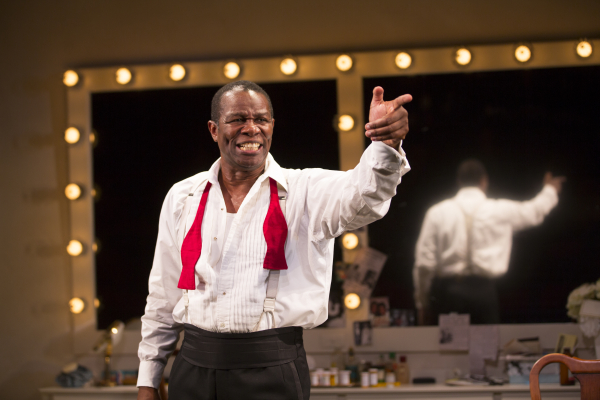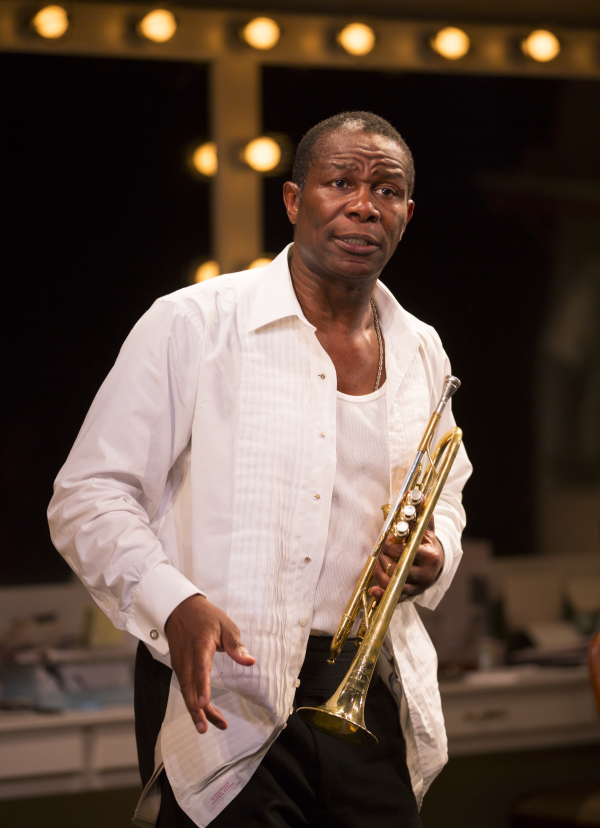Satchmo at the Waldorf

(© T. Charles Erickson)
It may surprise you to know that the beloved trumpeter and jazz great Louis Armstrong, whom many remember for his gravelly, grandfatherly voice and bright smile, dropped F-bombs regularly and smoked marijuana religiously. But it might surprise you more to know that this seemingly worldly musical legend had an innocent sensitivity that left him on the short end of business deals and shattered his faith in those he thought were his friends.
John Douglas Thompson brings Louis Armstrong blazingly to life at the Westside Theatre in Terry Teachout's remarkable Satchmo at the Waldorf, with inspired direction by Gordon Edelstein. The play does not pretend to be strictly biographical, but it's rooted in fact, taking place in a backstage dressing room at the Waldorf Astoria hotel in March 1971, only a few months before Armstrong's death from a heart attack. Thompson, stooped over slightly and speaking directly to the audience, creates an extraordinarily convincing portrayal of the foulmouthed, infectiously likable jazz legend, who learned to play the coronet as a poor New Orleans kid at a the Fisk School for Boys and later played for gangsters, such as Al Capone, in Chicago and New York.

(© T. Charles Erickson)
To say that Thompson's performance is a tour de force would be an understatement. This is a tour de megaforce. Thompson so fully embodies Louis "Satchmo" (short for "satchelmouth") Armstrong and so seamlessly transforms into the show's two other characters that you may remember the play as having been performed by three actors rather than just one. Thompson uncannily morphs into Armstrong's fast-talking manager Joe Glaser and jazz musician Miles Davis, each transformation assisted by Kevin Adams' superb lighting design. As the warm yellow of Armstrong's Waldorf dressing room changes to a chilly blue, Thompson becomes Glaser, standing erect and talking cagy business with his brassy voice. Then the lights dim to suggest the grainy illumination of a jazz club, where Thompson shows us a racially indignant Miles Davis speaking in an irascible loud whisper. When the yellow light returns and we see Thompson become the hunched-over trumpeter again, the effect is thrilling.
Just as seamless are the instantaneous scene changes that Lee Savage's set design allows. Three large dressing-room mirrors become windows as the lights dim, allowing locales to change along with Thompson's characters. It's the hallmark of this extraordinary production that the lighting, sets, and actor work together in one carefully interwoven whole.
There's a fair amount of acerbic racial discussion in Satchmo. In the wake of the civil rights movement, Armstrong was well aware that he was adored by white audiences and snubbed by many blacks, including Davis. Each of Thomas' characters must negotiate this complicated ethnic landscape of America, where a black jazzman could easily be construed as subservient to his white Jewish manager. It turns out that Armstrong, while savvy to the racial tensions around him, was easily hurt by Davis' and others' charges of Uncle Tomism, though when it came to the events in Little Rock, Satchmo was an unequivocally outspoken voice against injustices to blacks.
Satchmo at the Waldorf does not try to be comprehensive about Armstrong's life. Conspicuously absent are mentions of many notable people with whom he worked and performed, and the names we hear are often mentioned to emphasize a point, such as Armstrong's observation that every white man has a black man whom he takes an interest in. Bing Crosby loved him, Satchmo says, but never invited him to his house. Even among close "friends," race always mattered.
Regardless of omissions, there's more than enough in this play's emotionally charged 90 minutes to provide the essence of Armstrong's genius and humanity, and Thompson's breathtaking performance will leave you trumpeting the praises of both performers.










